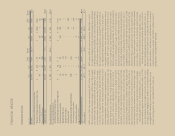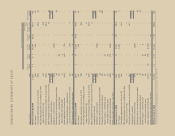Sara Lee 2011 Annual Report Download - page 74
Download and view the complete annual report
Please find page 74 of the 2011 Sara Lee annual report below. You can navigate through the pages in the report by either clicking on the pages listed below, or by using the keyword search tool below to find specific information within the annual report.
FINANCIAL REVIEW
believes are most likely to occur. If actual amounts are ultimately
different from previous estimates, the revisions are included in the
corporation’s results of operations for the period in which the actual
amounts become known, and, if material, are disclosed in the finan-
cial statements. The disclosures below also note situations in which
it is reasonably likely that future financial results could be impacted
by changes in these estimates and assumptions. The term “reason-
ably possible” refers to an occurrence that is more than remote
but less than probable in the judgment of management.
Sales Recognition and Incentives Sales are recognized when title
and risk of loss pass to the customer. Reserves for uncollectible
accounts are based upon historical collection statistics, current
customer information, and overall economic conditions. These
estimates are reviewed each quarter and adjusted based upon
actual experience. The reserves for uncollectible trade receivables
are disclosed and trade receivables due from customers that the
corporation considers highly leveraged are presented in Note 15 to
the Consolidated Financial Statements, titled “Financial Instruments
and Risk Management Interest Rate and Currency Swaps.” The cor-
poration has a significant number of individual accounts receivable
and a number of factors outside of the corporation’s control that
impact the collectibility of a receivable. It is reasonably likely that
actual collection experience will vary from the assumptions and
estimates made at the end of each accounting period.
The Notes to the Consolidated Financial Statements specify a
variety of sales incentives that the corporation offers to resellers
and consumers of its products. Measuring the cost of these incen-
tives requires, in many cases, estimating future customer utilization
and redemption rates. Historical data for similar transactions are
used in estimating the most likely cost of current incentive programs.
These estimates are reviewed each quarter and adjusted based
upon actual experience and other available information. The corpo-
ration has a significant number of trade incentive programs and a
number of factors outside of the corporation’s control impact the
ultimate cost of these programs. It is reasonably likely that actual
experience will vary from the assumptions and estimates made
at the end of each accounting period.
Inventory Valuation Inventory is carried on the balance sheet at
the lower of cost or market. Obsolete, damaged and excess inven-
tories are carried at net realizable value. Historical recovery rates,
current market conditions, future marketing and sales plans and
spoilage rates are key factors used by the corporation in assessing
the most likely net realizable value of obsolete, damaged and excess
inventory. These factors are evaluated at a point in time and there
are inherent uncertainties related to determining the recoverability of
inventory. It is reasonably likely that market factors and other condi-
tions underlying the valuation of inventory may change in the future.
Interest rate value at risk increased from 2010 due to a shift
toward longer maturities of the overall debt outstanding and the
general increase in long-term rate volatilities. Foreign exchange
value at risk decreased from 2010 primarily due to the decrease
in foreign exchange rate volatility in the current year.
Sensitivity Analysis
For commodity derivative instruments held, the
corporation utilizes a sensitivity analysis technique to evaluate the
effect that changes in the market value of commodities will have on
the corporation’s commodity derivative instruments. This analysis
includes the commodity derivative instruments and, thereby, does
not consider the underlying exposure. At the end of 2011 and 2010,
the potential change in fair value of commodity derivative instruments,
assuming a 10% change in the underlying commodity price, was
$22 million and $2 million, respectively. This amount is not signifi-
cant compared with the earnings and equity of the corporation.
Non-GAAP Financial Measures Definitions
The following is an explanation of the non-GAAP financial measures
presented in this annual report. “Adjusted net sales” excludes from
net sales the impact of businesses acquired or divested after the
start of the fiscal period and excludes the impact of an additional
week in those fiscal years with 53 weeks versus 52 weeks. It also
adjusts the previous year’s sales for the impact of any changes in
foreign currency exchange rates. “Adjusted operating segment
income” for a specified business segment or discontinued operation
excludes from operating segment income the impact of significant
items recognized by that portion of the business during the fiscal
period and businesses acquired or divested after the start of the
fiscal period. It also adjusts for the impact of an additional week
in those fiscal years that include a 53rd week. It also adjusts the
previous year’s operating segment income for the impact of any
changes in foreign currency exchange rates. “Adjusted operating
income” excludes from operating income the impact of significant
items recognized during the fiscal period, contingent sale proceeds,
if any, and businesses acquired or divested after the start of the
fiscal period. It also adjusts for the impact of an additional week
in those fiscal years that include a 53rd week. It also adjusts the
previous year’s operating segment income for the impact of any
changes in foreign currency exchange rates.
Critical Accounting Estimates
The corporation’s summary of significant accounting policies is
discussed in Note 2 to the Consolidated Financial Statements.
The application of certain of these policies requires significant
judgments or a complex estimation process that can affect the
results of operations and financial position of the corporation, as
well as the related footnote disclosures. The corporation bases its
estimates on historical experience and other assumptions that it
























